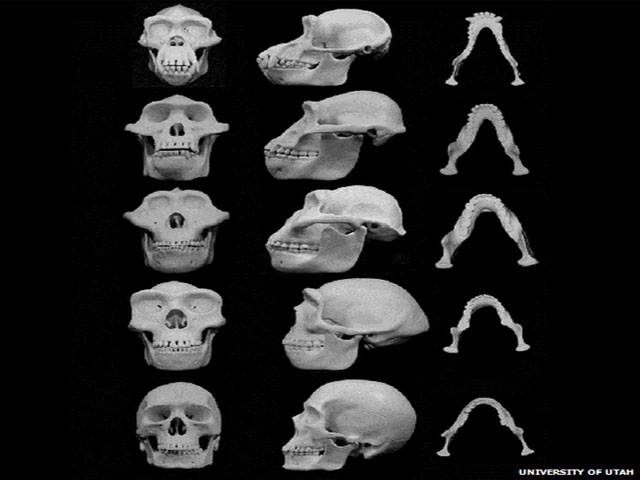BBC
Utah
A new theory suggests that our male ancestors evolved beefy facial features as a defence against fist fights.
The bones most commonly broken in human punch-ups also gained the most strength in early “hominin” evolution. They are also the bones that show most divergence between males and females.
The paper, in the journal Biological Reviews, argues that the reinforcements evolved amid fighting over females and resources, suggesting that violence drove key evolutionary changes. Fossil records show that the australopiths, immediate predecessors of the human genus Homo, had strikingly robust facial structures. For many years, this extra strength was seen as an adaptation to a tough diet including nuts, seeds and grasses. But more recent findings, examining the wear pattern and carbon isotopes in australopith teeth, have cast some doubt on this “feeding hypothesis”. “In fact, [the australopith] boisei, the ‘nutcracker man’, was probably eating fruit,” said Prof David Carrier, the new theory’s lead author and an evolutionary biologist at the University of Utah. Instead of diet, Prof Carrier and his co-author, physician Dr Michael Morgan, propose that violent competition demanded the development of these facial fortifications: what they call the “protective buttressing hypothesis”.
In support of their proposal, Carrier and Morgan offer data from modern humans fighting. Several studies from hospital emergency wards, including one from the Bristol Royal Infirmary, show that faces are particularly vulnerable to violent injuries.
“Jaws are one of the most frequent bones to break - and it’s not the end of the world now, because we have surgeons, we have modern medicine,” Prof Carrier explained. “But four million years ago, if you broke your jaw, it was probably a fatal injury. You wouldn’t be able to chew food... You’d just starve to death.”
The jaw, cheek, eye and nose structures that most commonly come to grief in modern fist fights were also the most protected by evolutionary changes seen in the australopiths.
Furthermore, these are the bones that show the most differences between men and women, as well as between our male and female forebears. That is how you would expect defensive armour to evolve, Prof Carrier points out.
“In humans and in great apes in general... it’s males that are most likely to get into fights, and it’s also males that are most likely to get injured,” he told BBC News.
Interestingly, the evolutionary descendents of the australopiths - including humans - have displayed less and less facial buttressing.
This is consistent, according to Prof Carrier, with a decreasing need for protection: “Our arms and upper body are not nearly as strong as they were in the australopiths,” he explained. “There’s a temporal correlation.”
The facial buttressing idea builds on a previous observation by Prof Carrier and Dr Morgan that the early hominins were the first primates to evolve a hand shape compatible with making a fist - and thus, throwing a punch.
Saturday, April 20, 2024
Male faces ‘evolved to take punches’

Caption: Male faces ‘evolved to take punches’
One killed, 8 injured in explosion at Hashd al-Shaabi militia group’s headquarters
3:21 PM | April 20, 2024
Govt approves army deployment for security during by-polls
3:05 PM | April 20, 2024
Pakistan spends one billion US$ on wheat import this year
2:53 PM | April 20, 2024
Barbados officially recognizes Palestine as state
1:27 PM | April 20, 2024
Heavy rains claim 98 lives, 89 injuries, across Pakistan: NDMA
1:21 PM | April 20, 2024
Policitising Tragedy
April 20, 2024
Tehran to Rafah
April 20, 2024
A New Leaf
April 20, 2024
A Tense Neighbourhood
April 19, 2024
Dubai Underwater
April 19, 2024
Dangers of Deepfakes
April 20, 2024
Feudalism
April 20, 2024
Kite tragedy
April 19, 2024
Discipline dilemma
April 19, 2024
Urgent plea
April 19, 2024
ePaper - Nawaiwaqt
Advertisement
Nawaiwaqt Group | Copyright © 2024





